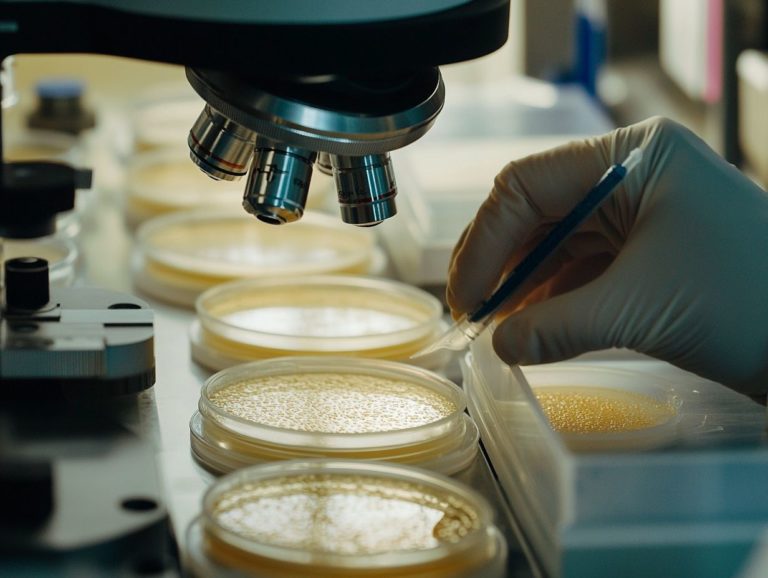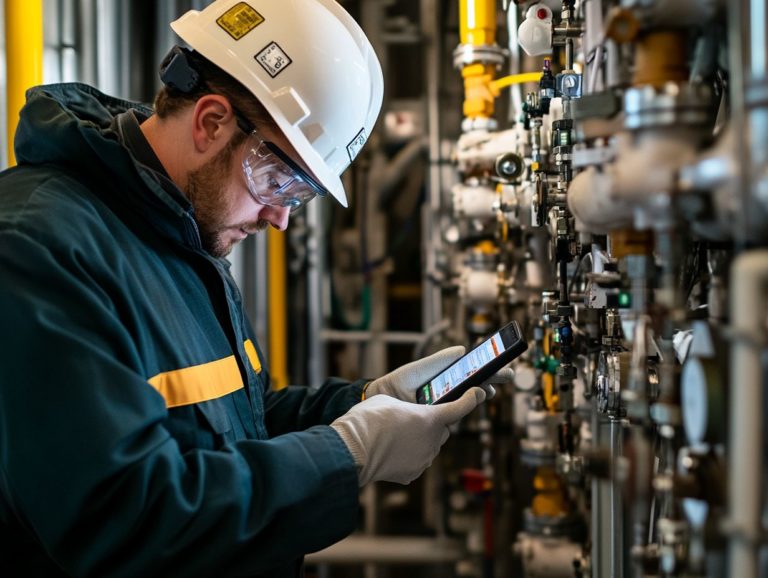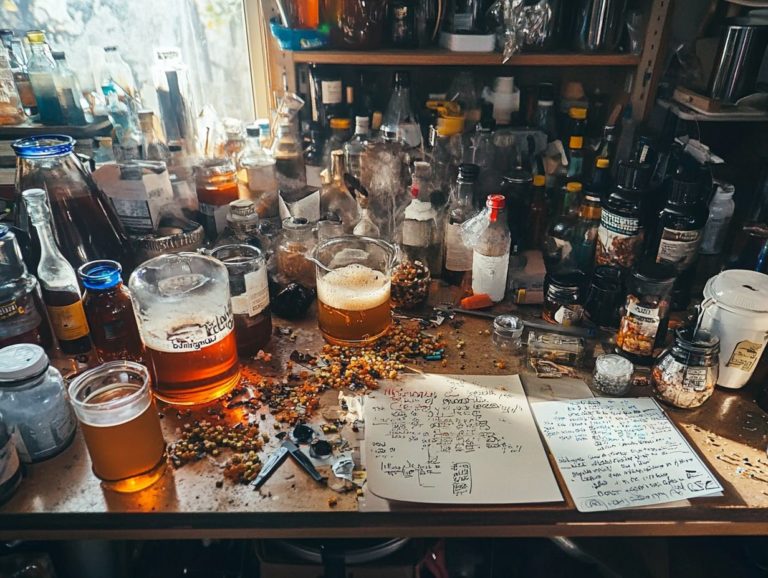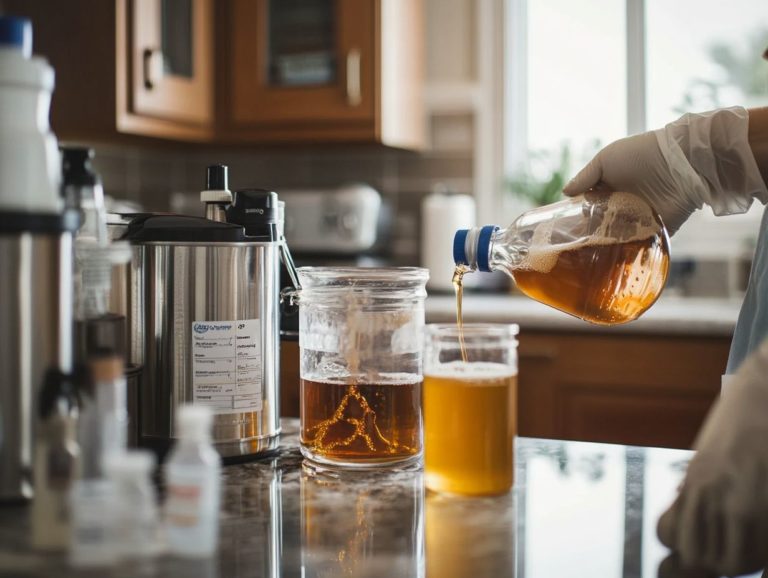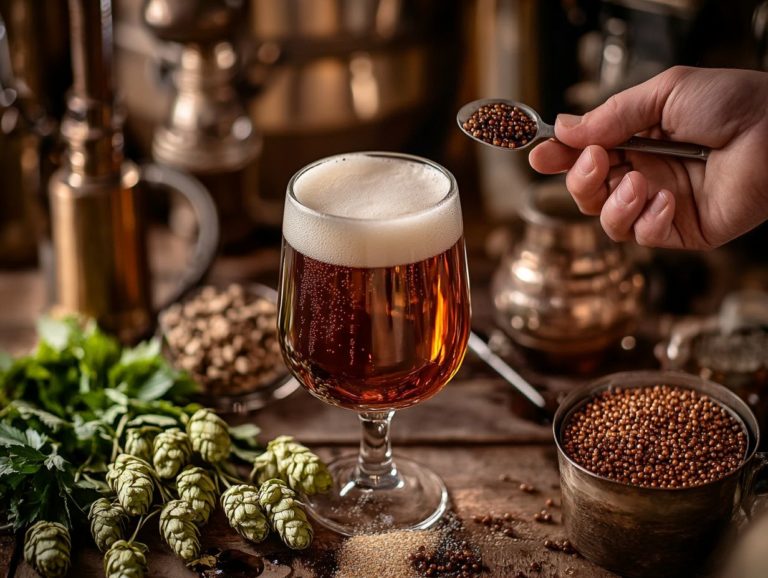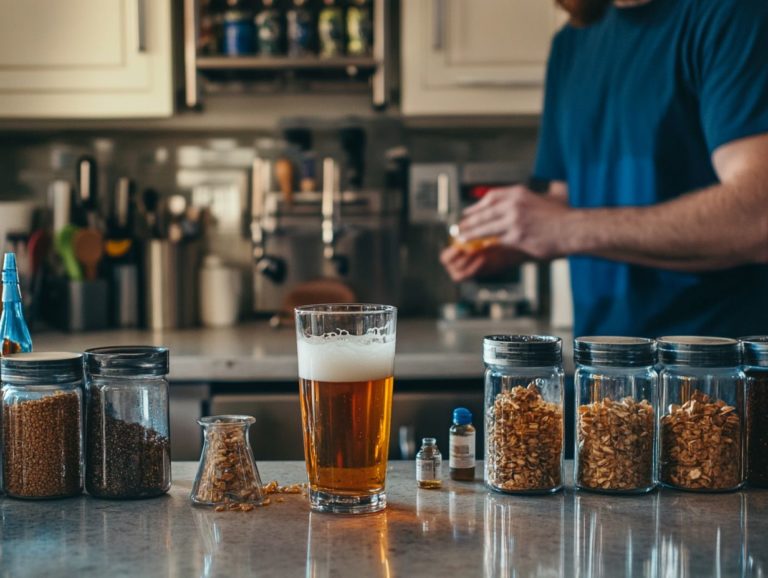5 Ways to Prevent Beer Spoilage
When it comes to relishing your favorite brew, proper storage is paramount to preserving its flavor and quality. Follow these easy tips to keep your beer fresh and delicious!
This guide presents five essential tips to help you prevent beer spoilage, ensuring that every sip is a delight. Begin by storing your beer in a cool, dark place, keeping it upright, and steering clear of temperature fluctuations these practices will significantly enhance your experience and prevent microbial contamination.
Be mindful of light’s impact on your beer, and familiarize yourself with the signs of beer spoilage. Understanding spoilage detection and sensory characteristics is crucial.
Contents
- Key Takeaways:
- 1. Store Beer in a Cool and Dark Place
- 2. Keep Beer Bottles Upright
- 3. Avoid Temperature Fluctuations
- 4. Limit Exposure to Light
- 5. Check Expiration Dates
- What Causes Beer to Spoil?
- Frequently Asked Questions
- What are some ways to prevent beer spoilage during transportation?
- How can beer spoilage be prevented at a bar or restaurant?
- Are there any natural ways to prevent beer spoilage?
- What should I do if I suspect my beer has been spoiled?
Key Takeaways:
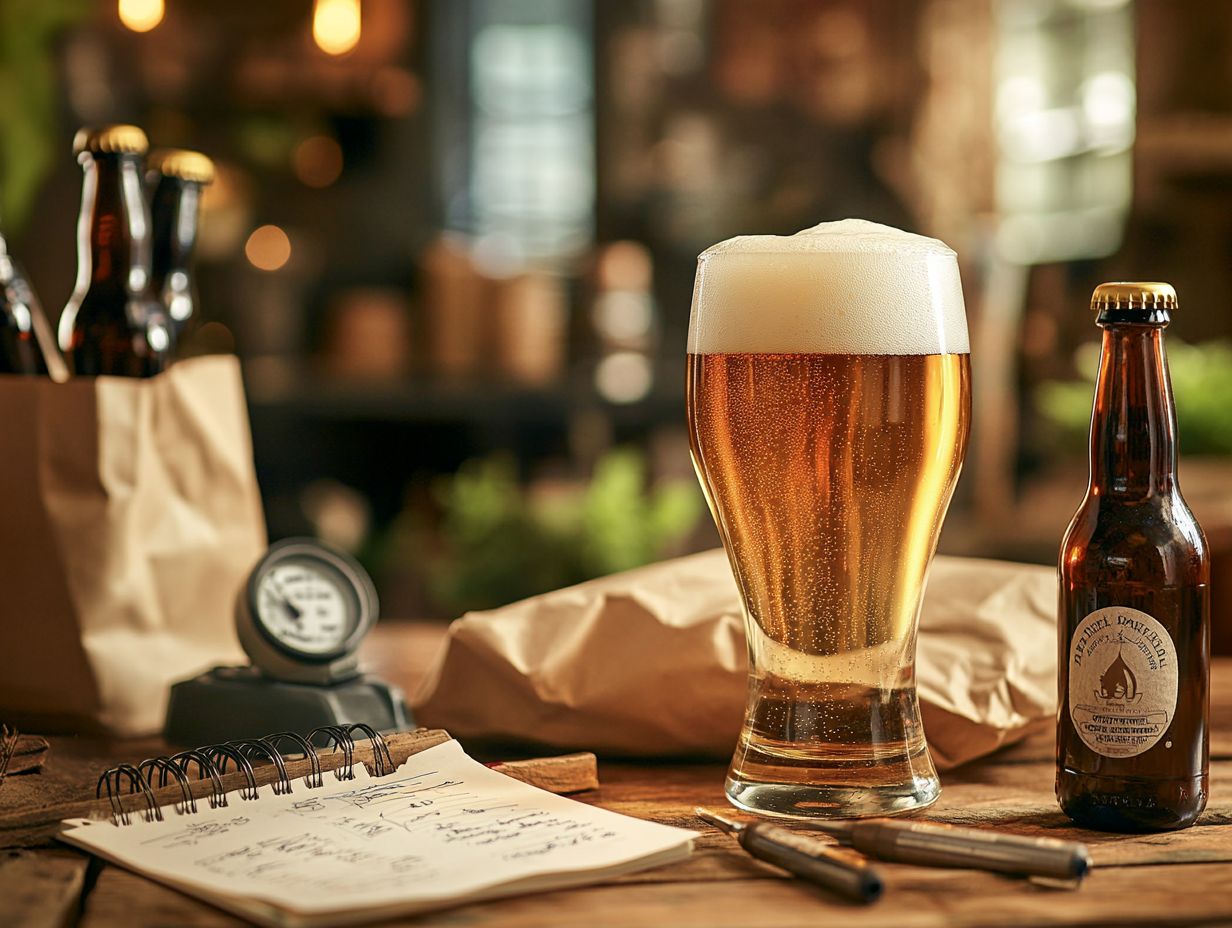
- Keep your beer in a cool and dark place to prevent spoilage.
- Store beer bottles upright to avoid oxidation and maintain freshness.
- Limit exposure to light and temperature fluctuations to preserve the flavor of your beer.
1. Store Beer in a Cool and Dark Place
Storing your beer in a cool, dark place is essential for preserving its quality and preventing spoilage. Beer is quite sensitive to temperature and light, which can negatively impact its flavor and aroma while promoting the growth of spoilage organisms like Lactobacilli, Pediococci, and Pectinatus.
As a part of brewery management, it s crucial to implement proper quality control measures, including environmental monitoring, to ensure your beer remains in peak condition and free from contamination.
Keep your beer stored at temperatures between 45 F and 55 F (7 C to 13 C). This temperature range minimizes the risk of unwanted fermentation activity and helps maintain the integrity of its flavors. Storing your beer at higher temperatures may accelerate fermentation, leading to off-flavors and heightening the risk of contamination from harmful bacteria.
Understanding the delicate balance of yeast species like Saccharomyces cerevisiae and the mix of helpful and harmful bacteria is crucial for you as a brewer.
By ensuring robust quality assurance protocols and a comprehensive quality control plan, you not only protect your product but also enhance consumer trust, ultimately safeguarding your brewery s reputation in a highly competitive market.
2. Keep Beer Bottles Upright
Keeping beer bottles upright is a straightforward yet highly effective practice for preserving the quality of your beer. This method prevents the beer from coming into contact with the cap, which can lead to oxidation and undesirable changes in flavor and aroma.
Maintaining the correct bottle position is essential for preventing contamination, as it minimizes the chance of sediment or particulates mixing with your product during storage, a common challenge in the brewing industry. Proper sanitation is critical to ensure that brewery equipment does not introduce unwanted flavors, pathogens, or beer spoilage microorganisms into the beer.
Proper handling throughout the brewing and packaging process is essential for safeguarding the integrity of each batch and reinforcing your overall quality assurance efforts, including the use of microbiological methods. This meticulous approach showcases your commitment to excellence, fostering trust and satisfaction among consumers.
3. Avoid Temperature Fluctuations
Avoiding temperature fluctuations is vital in the brewing industry. Inconsistent temperatures can lead to unwanted bacteria and fungi and spoilage, compromising the quality and flavor of your beer. This is where detection technologies like temperature monitoring systems come into play.
When stored at inappropriate temperatures, spoilage organisms like Lactobacilli, Pediococci, and Megasphaera thrive. This results in off-flavors and sour notes that stray far from the intended profile of your product. These bacteria flourish in warm environments, posing a significant threat to even the most meticulously crafted brews.
Maintaining consistent storage temperatures is essential for effective quality control in your brewery management. It enables you to minimize the risk of microbial growth and ensure that your final products meet the highest standards of freshness and taste.
Investing in reliable temperature monitoring and control systems can truly elevate your brewing game! You’ll safeguard your products like a pro throughout the brewing process, reducing the risk of microbial contamination.
4. Limit Exposure to Light
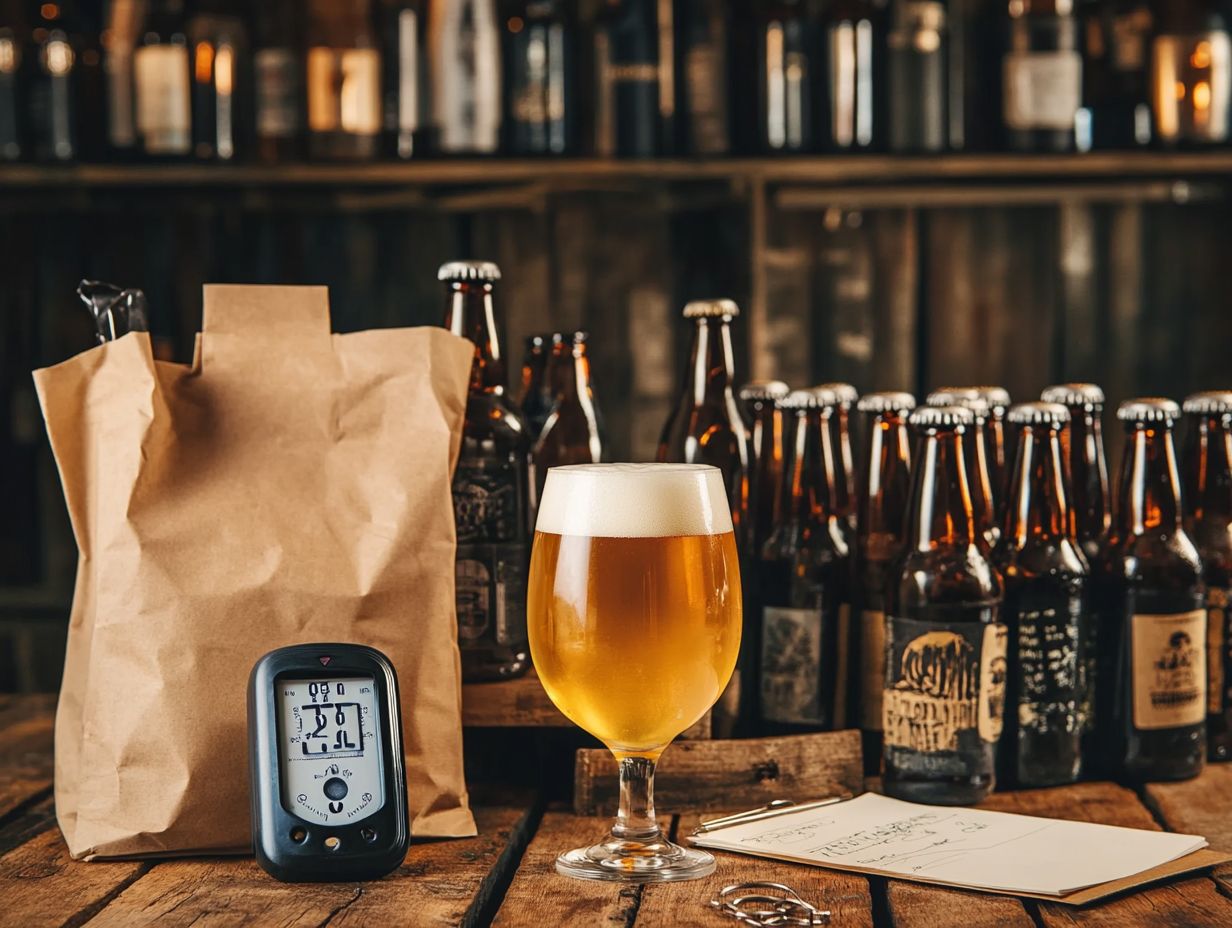
Limiting your exposure to light is crucial for preventing beer spoilage because UV light can break down essential compounds. This leads to off-flavors that compromise the sensory experience and overall quality of the brew. This is particularly vital in maintaining food safety standards.
Both sunlight and fluorescent lighting pose significant threats, as they emit wavelengths that can trigger photochemical reactions in the beer. This results in unwelcome changes in flavor and aroma, including potential Aflatoxin B1 contamination. This underscores the need for strategic packaging choices to preserve the quality of your beer.
For instance, dark glass bottles are a smart choice, as they significantly reduce light penetration compared to clear or green bottles. Using dark glass or aluminum containers aids in preventing contamination.
Cans, on the other hand, provide a complete barrier to light exposure, making them an excellent option for maintaining the freshness and integrity of your beverage. By prioritizing thoughtful packaging solutions, you can effectively protect your products against light-related spoilage, ensuring a superior experience for your consumers.
5. Check Expiration Dates
Regularly checking expiration dates is essential for maintaining the quality of your beer and preventing spoilage. This is a part of effective quality control practices. Consuming beer past its expiration can lead to undesirable flavors and a greater risk of microbial contamination, including spoilage by beer spoilage microorganisms.
To determine these dates, you should carefully assess several factors, including the ingredients used, the production methods, and the intended storage conditions. Incorporating tools like the ATP bioluminescence test can enhance your quality control measures. Quality control is vital in this process, as breweries conduct extensive testing to understand how different factors influence the beer’s longevity. Using Universal Beer Agar for microbial testing can help identify specific spoilage organisms.
As a consumer, being aware of tips for optimal consumption timing is crucial. Here are a few guidelines to keep in mind:
- Store your beer in a cool, dark place.
- Keep it upright to minimize sediment disturbance.
- Watch out for any signs of spoilage, such as off-odors or unusual haze.
Avoiding contamination is paramount. Always use clean glasses and steer clear of cross-contamination with other substances to preserve the beer’s intended taste and quality, a practice strongly advocated by experts like Ron Barchet.
What Causes Beer to Spoil?
Beer spoilage can arise from various factors, with spoilage organisms like Lactobacilli, Pediococci, Megasphaera, and Candida pelliculosa being the primary culprits. These organisms thrive in poorly managed brewing conditions, leading to microbial contamination and off-flavors that can compromise the quality of your beer. Effective environmental hygiene practices are essential to mitigate these risks.
These unwelcome guests flourish in specific temperature ranges, typically above 20 C, and take advantage of inadequate sanitation practices during fermentation and storage. Employ effective cleaning measures and manage the fermentation process critically to combat this. Ensure a sterile environment and control oxygen exposure while maintaining optimal pH levels to hinder their growth.
Implementing rigorous quality assurance protocols throughout your brewing process is essential to defend against spoilage. Companies like Hygiena offer advanced solutions for environmental hygiene and quality control. This involves regularly monitoring yeast health, conducting microbial testing, and adhering to strict cleanliness standards to protect your final product from the detrimental effects of spoilage microorganisms. Utilize effective filtration processes to prevent contamination.
How Does Light Affect Beer?
Light exposure significantly impacts beer, triggering chemical reactions that lead to spoilage and affect its sensory characteristics. This can result in unpleasant skunky flavors and a decline in overall quality.
The spoilage primarily stems from the breakdown of iso- -acids the bitter compounds derived from hops used during brewing. When beer is exposed to light, especially ultraviolet light, these iso- -acids can degrade, ultimately producing 3-methyl-2-butene-1-thiol (MBT), the culprit behind that unwelcome skunky aroma.
To tackle this issue head-on, implement effective quality control measures. Opt for darker glass bottles or aluminum cans, which block UV light effectively. Make sure your storage and transport environments minimize light exposure. Investing in high-quality brewing equipment can help maintain optimal storage conditions. This approach preserves the integrity of the beer’s flavors and aromas, enhancing the overall experience for consumers.
What Are the Best Storage Practices for Beer?
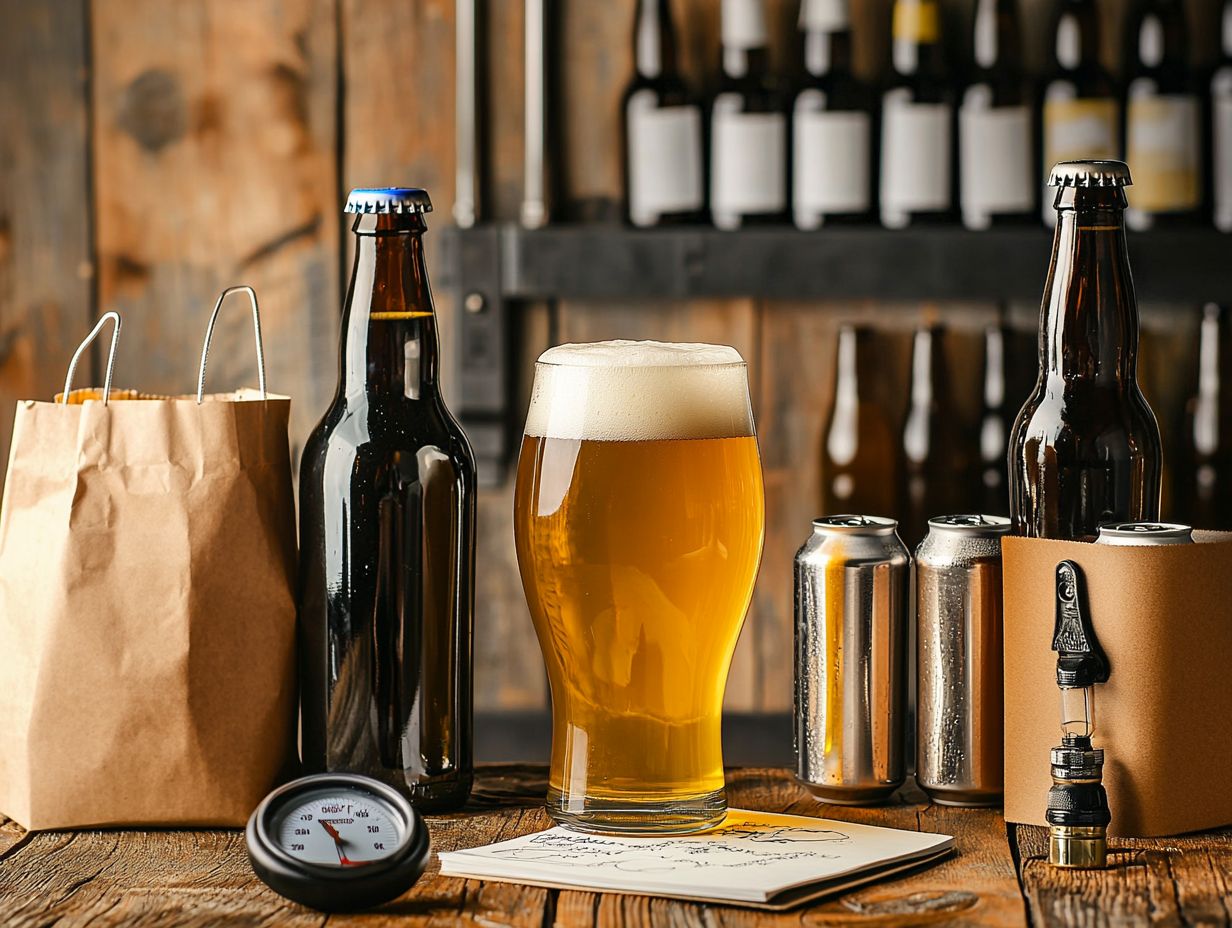
The best practices for storing beer involve keeping it in a cool, dark environment. Ensure it stands upright to prevent contact with the cap and protect it from temperature fluctuations to safeguard against spoilage and maintain its optimal quality.
Don t wait invest in high-quality, insulated storage containers that shield against light exposure and help maintain consistent temperatures. Choose dark glass or aluminum containers, as these materials effectively protect the beer from harmful UV rays.
Regular inspections of your storage areas are essential. Ensure that cleanliness and hygiene practices are strictly followed to minimize the risk of contamination. Using advanced spoilage detection methods can enhance these efforts.
Implement a rigorous inventory rotation based on a first-in-first-out system. This is a crucial part of a comprehensive quality control plan. This approach significantly contributes to maintaining freshness and helps uphold excellent quality assurance standards within your brewery. Implementing stringent spoilage detection protocols ensures the best outcomes.
How Can One Tell If a Beer Has Spoiled?
You can identify spoiled beer through sensory evaluation methods that reveal off-flavors, unusual aromas, and visual cues like cloudiness or sediment. These signs can indicate microbial contamination or spoilage caused by spoilage organisms such as Lactobacilli and Pediococci.
Advanced laboratory techniques, such as gas chromatography and mass spectrometry, are essential in pinpointing specific spoilage compounds. They offer detailed insights that sensory methods might miss. By monitoring changes in chemical composition and detecting unwanted microorganisms and bacterial species, these technologies significantly enhance quality control measures within the brewing process.
The integration of these detection technologies is crucial for quality assurance. They ensure that your products meet safety standards and satisfy consumer expectations. When you combine sensory evaluation with scientific approaches, you can maintain the integrity of your beer and uphold a consistent flavor profile that your loyal customers can always count on.
What Are the Most Common Causes of Beer Spoilage?
The most common causes of beer spoilage can often be traced back to the presence of spoilage organisms like Lactobacilli, Pediococci, and Pectinatus. These nuisances are frequently linked to inadequate sanitation practices and lapses in quality control within brewery management.
These issues often come from the quality of raw materials used during brewing. Contaminated grains or uninformed sourcing can introduce unwanted pathogens that jeopardize your brew. Additionally, improper fermentation whether due to temperature fluctuations or insufficient oxygen management can create a perfect storm for spoilage during the fermentation process.
Good brewery management is crucial for keeping your beer safe and tasty! By meticulously monitoring every stage, from the selection of raw ingredients to the conditions of fermentation, you can safeguard your products against spoilage and uphold a high standard of beer quality.
What Are Some Tips for Preventing Beer Spoilage When Traveling?
When you re traveling, preventing beer spoilage becomes essential. Here are some practical tips to keep in mind:
- Ensure proper storage conditions and avoid temperature fluctuations.
- Check expiration dates to maintain the quality of your beer.
- Consider environmental monitoring in such scenarios.
Be mindful of how you pack your beverages. Opt for insulated coolers or bags to protect your precious cargo from extreme temperatures. It s also wise to keep your beer upright; this minimizes sediment disturbance and reduces the risk of leakage.
Incorporating a thermometer into your packing can help you monitor the internal temperature of your storage area, ensuring it remains within the optimal range. These methods are a part of larger contamination prevention strategies.
Know local regulations regarding alcohol transportation to navigate your adventure smoothly while enjoying your drinks. By following these guidelines, you can savor your chosen brews without the worry of spoilage or contamination, ensuring the highest beer quality.
Frequently Asked Questions

What are the main causes of beer spoilage?
The main causes of beer spoilage are exposure to oxygen, light, heat, bacteria, or wild yeast contamination, and improper storage conditions. Specific beer spoilage microorganisms like Megasphaera and Candida pelliculosa can also be significant contributors.
How can I prevent beer spoilage at home?
There are several ways to prevent beer spoilage at home:
- Store beer in a cool, dark place.
- Minimize exposure to oxygen by keeping the bottle or can sealed until ready to drink.
- Clean and sanitize all brewing equipment and bottles used for homebrewing.
Implementing a quality control plan can further help in maintaining the beer’s integrity.
What are your favorite tips for keeping beer fresh? Share with us!
What are some ways to prevent beer spoilage during transportation?
To prevent beer spoilage during transportation, keep the beer in a cool environment. Minimize movements to avoid agitation and oxygenation.
Using insulated containers and packing the beer tightly helps prevent spoilage. Also, practice good environmental hygiene.
How can beer spoilage be prevented at a bar or restaurant?
At a bar or restaurant, regularly clean and maintain all tap lines and equipment. Store the beer at the right temperature and rotate stock for freshness.
Monitor cleaning effectiveness with tests to ensure that all surfaces are sanitized properly.
Are there any natural ways to prevent beer spoilage?
Yes! Adding hops can help prevent spoilage due to their antimicrobial properties. High-quality ingredients and proper sanitation also play a vital role.
Some brewers use special agar for microbial analysis during the brewing process.
What should I do if I suspect my beer has been spoiled?
If you think your beer might be spoiled, don t take the risk just toss it! Consuming spoiled beer could lead to unpleasant flavors and health risks.
Regular sensory evaluations can help catch spoilage early.

